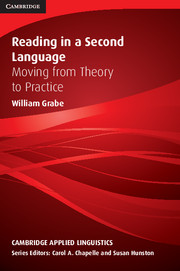Book contents
- Frontmatter
- Contents
- Series editors' preface
- Preface
- I FOUNDATIONS OF READING
- II PATTERNS OF VARIATION IN READING
- III DEVELOPING READING COMPREHENSION ABILITIES
- IV EXPANDING READING COMPREHENSION SKILLS
- Chapter 14 Reading fluency, reading rate, and comprehension
- Chapter 15 Extensive reading
- Chapter 16 The reading curriculum and instruction
- Chapter 17 Reading assessment
- Chapter 18 Further topics and issues in reading
- References
- Author Index
- Subject Index
Chapter 14 - Reading fluency, reading rate, and comprehension
from IV - EXPANDING READING COMPREHENSION SKILLS
Published online by Cambridge University Press: 05 August 2012
- Frontmatter
- Contents
- Series editors' preface
- Preface
- I FOUNDATIONS OF READING
- II PATTERNS OF VARIATION IN READING
- III DEVELOPING READING COMPREHENSION ABILITIES
- IV EXPANDING READING COMPREHENSION SKILLS
- Chapter 14 Reading fluency, reading rate, and comprehension
- Chapter 15 Extensive reading
- Chapter 16 The reading curriculum and instruction
- Chapter 17 Reading assessment
- Chapter 18 Further topics and issues in reading
- References
- Author Index
- Subject Index
Summary
Clearly, the ability to read accurately and rapidly is so fundamental to reading success that it just has to be right.
(Kame'enui & Simmons, 2001: 204)Reading fluency – what good readers do on a continual basis with most reading material that they encounter – is an essential component of efficient reading-comprehension abilities. Fluent L1 readers can recognize almost every word they encounter in a text automatically. Fluent L1 readers can read a passage aloud at a rapid steady rate with good comprehension and with little hesitancy due to the basic syntax or the words they encounter. Fluent L1 readers read most texts at between 250–300 words per minute. Finally, fluent L1 readers can read for extended periods of time without difficulty or effort. Research has associated fluent reading of words with reading-comprehension abilities in L1 studies of young children. Oral passage reading rate and extensive reading are also strongly associated with L1 reading-comprehension abilities at multiple age levels. In L1 contexts, fluency research and teacher-resource books have emerged at a notable rate over the past decade, giving L1 reading fluency much greater recognition (Adlof, Catts, & Little, 2006; Breznitz, 2006; Kuhn & Schwanenflugel, 2008; Kuhn et al., 2006; Miller & Schwanenflugel, 2006; National Reading Panel, 2000; Rasinski, 2003; Rasinski, Blachowicz, & Lems, 2006; Samuels & Farstrup, 2006; Schwanenflugel et al., 2006; Spear-Swerling, 2006).
The situation is different for L2 reading research and instruction. At present, relatively little research has been conducted on word-reading fluency or on oral reading-rate fluency in L2 settings.
- Type
- Chapter
- Information
- Reading in a Second LanguageMoving from Theory to Practice, pp. 289 - 310Publisher: Cambridge University PressPrint publication year: 2008



